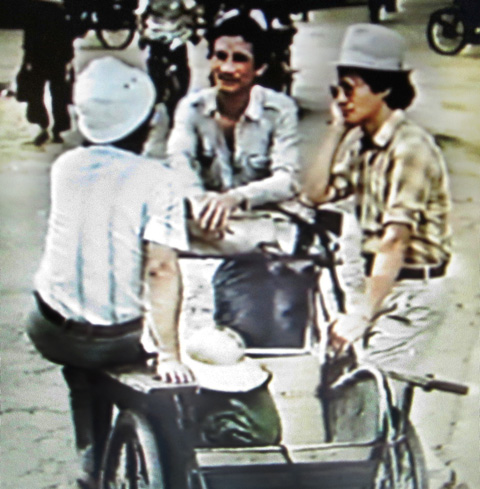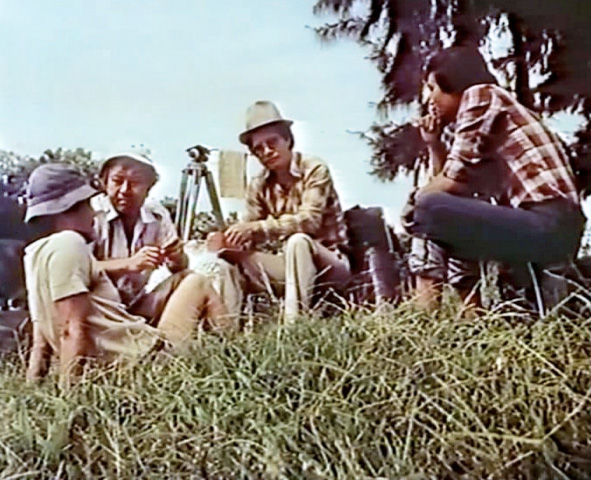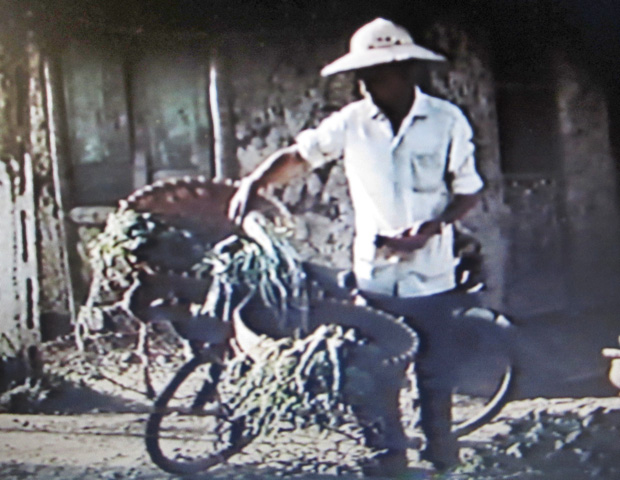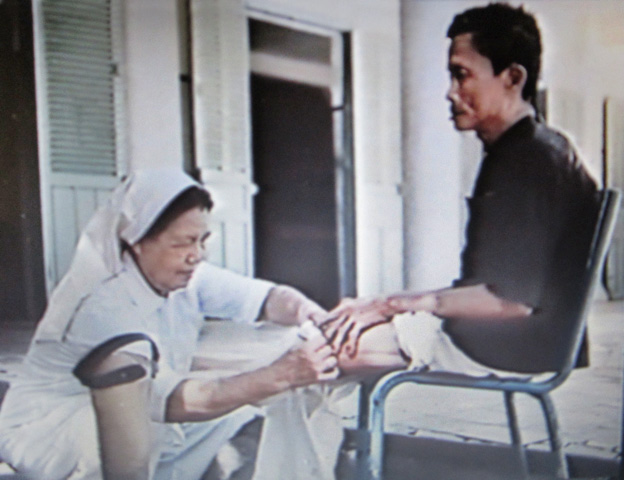Chapter Fourteen
Talking with the American researchers Prof. Michael Renov and Dr. Dean Wilson, I shared with them my memories concerning the making of The Story of Kindness.
The filming of The Story of Kindness began in 1985, at a time when Hanoi In Whose Eyes was still banned, and I was being monitored by the police. The social and economic circumstances in 1985 prompted and guided me in choosing the theme of this film. It began when a very close colleague of mine, Mr. Đồng Xuân Thuyết, fell ill with cancer. We decided to turn on our film cameras.
One year later he passed away, and one year after that was his first death anniversary. So filming this personage made it necessary to wait about two years before the film was complete. When we filmed Đồng Xuân Thuyết, many people in the studio objected, saying that there was nothing special about him, that he was a person who had made no special contributions or received any special honors, and that he was not a party member. But it was clear that he was suffering a fate common to us all, so we began filming him. Đồng Xuân Thuyết was a person loved and valued by everyone, not because he had great gifts, unusual wealth, or any special status, but because his loyal and sincere way of living made everyone love him and believe in him. I thought that since he had cancer, the chances for his recovery were very low, and that his death would make for a good film. But if he didn’t die, the film would have to be cast aside.
There was a time in his illness when a friend named Lò Minh had him drink the gall bladder juice of bears, and he got healthier. Thuyết roared up on his motorcycle to my house on Hàng Bún Street and shouted “Thủy! I’m not going to die! Your film’s spoiled!” I went down and greeted him, thinking “If this film project doesn’t work, I’ll make another one, but if Heaven takes pity on a good friend like him, nothing could be better!” A few months later, however, Thuyết passed away in Thủy Nguyên, Hải Phòng, his hometown. Before dying, he howled like a madman every night. Yes, we followed this personage for two years, starting and ending the film with Thuyết.
And then I heard stories about people with leprosy being neglected and scorned, and stories about bicycle repairmen who were former colonels with distinguished war records.
In my entire professional life, I have never made any film with such a vague idea like the film that came to be named later as The Story of Kindness. In order to make this film, the people in our crew agreed with each other, “We know it when we made it”. Mr. Hồ Trí Phổ drafted a script entitled “On Human Suffering” to submit to the studio directors. It was only a sketchy outline concerned with love and misfortune, doctors and patients, lepers and nuns—it was written in a very noncommittal manner, so that our directors would feel reassured that we were making an ordinary, mediocre film.
As for the real script, we didn’t actually have one; it took shape only gradually in our heads, as we carried on. This had nothing to do with any talent or skill of mine; I would urge all film students never on any account to work in this manner. What happened then was perhaps due to some supernatural force pushing us on to the final result.
We felt that the film had to have a cyclo driver in it, together with his feelings and family circumstances. We went searching for a cyclo man at Hàng Cỏ Central Station. Among all the drivers waiting for customers, there was a tall, handsome young fellow wearing a torn pair of jeans. Our crew commented that this fellow looked a bit “cà chớn” (anomalous) as his appearance was not that of a typical cyclo man. We approached him and asked,
“Excuse us, are you available to take a customer?”
“Yes sir, I’m waiting for a customer right now.”
“So are you a professional cyclo driver, or are you…?”
“I’m doing it for real, to seek a living and feed my children and family, sir.”
“Then could you allow us to film you working for a while?”

“I’m doing it for real, to seek a living and feed my children and family.”
At that time, our intention was quite simple; we would shoot him along the road in front of Reunification park (near the station), taking close-ups, middle-distance shots, and wide view shots showing the entire setting, without any idea how to make sense out of those scenes. But when we got to the park gate it was raining hard, so we decided to step into a café and have some things to drink, while we waited for the rain to clear up. We asked each other polite questions to make conversation: “What’s your name? What did you do during the war years?” Only then did the young man relate to us that he had been a security officer for the Party committee of the 5th Zone, where I had been as well. At that time his wife was also there working as a doctor. When the war ended, he became a security officer in the Four-Party Joint Military Commission [Tân Sơn Nhất Airport in Saigon].
I was astounded and thought to myself, “Here’s a poor fellow “ất ơ” (hanging around) on the street whom we met by chance—he seemed just like anyone else, but when we happened to ask him some casual questions, he turned out to be a person with such a meritorious background! This was no longer a joke. I said, “Well, go ahead, finish your drinks and go home. Tonight let’s think about what to shoot and what to write—if we start shooting right away, we’ll have no idea what to shoot.
The way we made the film was… we would go places, searching as we went, and would shoot scenes, thinking as we shot them, with no preconceived plan whatsoever. When I decided to invite Lê Văn Long to be my principal cameraman, we were again waiting for the weather to clear up, so I asked him a casual question to start a conversation:

The way we made that film was… we would go places, searching as we went, and would shoot scenes, thinking as we shot them, with no preconceived plan whatsoever.
“Where is your home village?”
“My home village is in Thường Tín. You doubtless have no idea that when I go back to my village, I’m quite a big shot. My village is poor—everyone there tends ducks, grows rice, cultivates potatoes, and does miscellaneous work. Only I work as a cameraman.
Only later when I visited him at home, did he tell me the following story:
Once in my childhood, when I went out duck herding, I was overcome with exhaustion, so I crept into a thatched hut and slept—then the ducks broke into some paddy fields and ate some rice plants belonging to the cooperative. The elders in the village committee made a note of this duck incident in my “lý lịch” (personal record), and the result was that I was unable afterward to get into any university. Whenever I took an entrance exam, I would be rejected because of my record. Later on, just by chance, I got admitted to a film school (then a secondary vocational school). So I suddenly turned into a cameraman and became the most prestigious fellow in the village.
On my return to the studio, I went at once to the personnel office and asked the people there to show me Long’s “lý lịch.” Sure enough, the notation Long referred to was right there in the record! However amusing Long’s story might appear, it gave me great pain, because at that time, “chủ nghĩa lý lịch” or “resumé-ism”—the practice of making everything depend on a man’s personal record—was still immensely heavy and pervasive. This was a problem affecting not just Long alone, but the whole society. “Resumé-ism” held the nation in a vice, and polarized people’s souls.
Why should such a trivial detail shock people? Because it touched upon some issues in that era which had torn the country apart, with bizarre consequences.
Later on, Long related to me how in his school days at the Tô Hiệu High School in Thường Tín, his mathematics teacher was Lê Văn Chiêu—an excellent teacher who had to abandon his profession and become a vegetable vender. This was not a story that concerned Lê Văn Chiêu alone, but rather the mistreatment of intellectuals that went on in the entire society.
Taking us to a market at the end of Bạch Mai Street, Long pointed to a man selling vegetables and said, “There! That’s my teacher!” After that, I sent Long to Teacher Lê Văn Chiêu’s home to ask for permission to film him.
Teacher Chiêu said, “All right—whenever you want to film me, let me know beforehand. After I come home from the market I’ll wash up, change my clothes, make tea, and talk with you, so you can film me.”

“There! That’s my teacher!”
Nothing we said could persuade him to let us film him at the market. The scenes that appear in the film seem simple, but they were complicated to make, because they had to be shot by a hidden camera without his permission
Whatever I perceive to be necessary and useful to a film, I’ll always find some means to accomplish. I said to Long, “The day after tomorrow, we’ll shoot at the market, but you must stay at home, without coming to the scene, okay?
I asked a different cameraman, Nguyễn Trung Hiếu, to do it. I told Hiếu that he was to pretend that he was shooting scenery for a tourist film. He was to stand with his back to Mr. Chiêu in a posture that would allow him to turn 360 degrees. That was how all the segments taken by stealth were shot. Later when the film came out, and rumors about these scenes reached the ears of Mr. Chiêu, he made his way to the Polytechnic University, where he bought a ticket and watched the film. After that he couldn’t sleep for several nights. He had Long come to see him and said, “I was very displeased because people told me that you had filmed me. I didn’t want to cast aspersions on the regime. But now, thinking it over, I see that you’ve said nothing wrong.”
Working with film (not video) means that you have to deal with vehicles and machinery, including sound equipment. Nevertheless, we kept dragging this cumbersome stuff around on the road with no clear plan in our heads, nor any defined list of personages to put in the film. It was bizarre; no one at all makes films like that.
While staying at the Bạch Mai hospital, I wrote quite a bit; during the ten days I stayed there awaiting the results of blood tests and x-rays, I finished a version of the script that I was pretty well satisfied with. I asked to check out from the hospital, because my I had recovered.
The doctor laughed and said, “You’re still in the observation phase—you haven’t taken any medicine or received any treatment!”
But the fact was that, having written the script, I felt much better. My medical record back then had been registered in the “Việt-Xô” Hospital, a hospital reserved for high-ranking cadres. Conditions there were better; each room had at most only three or four beds, and the patients were attentively taken care of. It wasn’t noisy and messy like the Bạch Mai Hospital, which at the time catered to “thập loại chúng sinh” (all sorts of sub-human beings). The room where I lay was as wide as a public theatre and had several dozen beds. Venders went throughout the ward shouting, “Who wants sticky rice! Who wants a drink!”
That was precisely my reason for writing the script in the Bạch Mai Hospital. Only by staying right there could I really understand that in this life no one is so foolish as to throw away their comfort, affluence and status in order to live the lives of ordinary people.
In the final part of the film, I wrote, “It has taken us a very long time to learn that to understand the suffering of others is not an easy thing at all.”
No, it’s not easy. Especially if you can’t live other people’s lives. It’s only through living other people’s lives, sharing their sorrows and joys, that we’re able to discover, understand, contemplate, and do a few things correctly. But like us, very few if any would be so crazy as to reject a more comfortable and powerful life in order to live the life of common people. Herein lies the paradox. Despite all our efforts and pains, what we the filmmakers have finally learnt is but a drop of water, and what we still don’t know is an ocean
The scene in the film at that point shows us sitting in a car, chewing gum and smoking, while the common people struggle miserably along the road, some pushing ox-carts, and others carrying shoulder-loads. Those images accompany the words above.
Many people, including Dean Wilson and Michael Renov, have observed that we turned ourselves into objects of ridicule in this film. This starts right at the beginning of the film, in the place where the brickmaker chased us away, and we said in response, “Yes! Our profession is indeed cowardly and insignificant. It is cowardly, because, though we have many thoughts, we dare not speak out; and it is insignificant, because no one needs what we make.”
It seems that up to 1985, there had never been any film, performance, or newspaper article that dealt fairly with people of the Christian faith; in other words, that spoke of the active determination with which they offer up their intelligence, their energy, their emotion, and even their lives, in order to save and serve humanity.
It must be acknowledged that nearly all of them are decent people, who know how to love and trust other human beings, and who are honest, trustworthy, telling no lies. .
When, in the course of making this film, I observed the devotion with which the nuns cared for the lepers in the Quy Hoà Leprosoreum, I was very moved. In those years the camps where lepers were cared for were medical institutions dependent on charitable contributions. Most of the government cadres who came to work in those places did so unwillingly. Fortunately, the former director of the Quy Hòa Leprosoreum when I was filming The Story of Kindness is still alive; his name is Trần Hữu Ngoạn, and his home is right by Chợ Bưởi (Bưởi Market), near where I live. He was like a saint, kind to the point of oddity. He was the embodiment of a person endowed with tử tế—decency. It was thanks to him that we were allowed to enter the Quy Hòa Lepresorium to film scenes and witness the actual lives of the Catholic sisters who worked there. The sisters lived in rooms that had nothing in them but a bed 80 centimeters wide and 1.8 meters long, and a nun’s habit hanging from a nail on the wall.

They went by stealth from various churches to charity-supported camps, so that they could serve people with leprosy!
And their presence there was illegal! Without residence permits, they went by stealth from various churches to charity-supported camps, so that they could serve people with leprosy!
They had to sneak around because they had no permission to do what they were doing.
When he was prime minister of Vietnam, Mr. Phan Văn Khải once observed to a group of religious leaders that social ills were fewer within religious communities than elsewhere. There were fewer problems with drug addiction, theft, muggings, and fraud, because in those places people knew enough to fear these things, even though their fear was based on vague ideas, without any clear explanations. A society consisting entirely of people with no religion, people who neither fear nor believe in anything, is an extremely dangerous society.
Before making this film, I had to do quite a bit of reading.
Napoleon is a person much celebrated for his ability to use military might to govern all the realm, but he was also the person who had a civil law code made that has become the foundation stone of the law codes of all the nations of Europe; and one may even say that Europe in some sense gave birth to the United States, and that the United States inherited the spirit of the Napoleonic Code.
So, if you have military power, and you have a code of law, is that enough to maintain yourself in power?
No! He (Napoleon) still felt that people’s lives lacked stability.
Toward the end of his life, he felt compelled to exclaim, “A people devoid of religion can be governed only by guns and bullets!”
But if you govern a people by means of guns and bullets that in itself means that the situation is not peaceful! From this we can see the importance of the role played by religions.
When we finished making the film, we put it aside and didn’t show it to anyone whatsoever; and it was necessary to fabricate excuses for this concealment, so as to delay the time when the film would be handed over to the studio directors, in a usual procedure…
And so at the end of 1987 The Story of Kindness was screened publicly.
It was said by all that this was done by the instruction of the Party General Secretary, so not a single censorship board dared raise an objection.
And immediately after that, the film was shown widely from the South to the North; and it became the turn of Hanoi in Whose Eyes to follow in the new film’s wake—it was also shown; and this was the first time in the history of Vietnamese cinema that tickets were sold for money to viewers to see documentary films.
In March 1988, at a national film festival in Đà Nẵng, Hanoi in Whose Eyes won a special Golden Award, including awards for the filmscript, the directing, and the camerawork.
But The Story of Kindness began to be ignored. This film became known through an article by Mathias Weile, a correspondant from ADN (the East German News Agency) stationed in Hanoi, which was printed in all the newpapers of East Germany and then spread to other countries. When they came to Vietnam to attend the March 1988 film festival in Đà Nẵng, almost all the members of the international delegations knew that there was such a film, and when they looked at the festival program, they saw The Story of Kindness printed there; but in the end they were unable to see it.
Among the international delegates, a most important personage was Santiago Anvares, a director from Cuba with a worldwide reputation. He was a person with many accomplishments concerning Vietnam, having made thirteen or fourteen films dealing either with Vietnam during the war, or providing portraits of Hồ Chí Minh. He was regarded as a very close and reliable friend of Vietnam. Yet he said, “It is very strange that though the program lists The Story of Kindness, we have not gotten to see it. By rights all the cinematic venues in Đằ Nẵng ought to be showing this film, so that the people can see it, but there isn’t a single place where it is being shown. We therefore need to see this film.”
But the organizing committee continued to ignore the matter and responded to inquiries in a vague, evasive manner. Mr. Anvares, however, demanded to see the film, together with other international delegations, such as those of Poland, Russia, and East Germany.
At that time my friends and I were feeling festive because we had just received a prize for Hanoi in Whose Eyes, but I didn’t have the right to demand that the The Story of Kindness be shown because the title appeared in the program. To tell the truth, I don’t know when creative artists in Vietnam will ever have that right. To show it or not was up to the organizing committee, but they were following orders from above to avoid and ignore the matter.
Even though Mr. Nguyễn Văn Linh had turned on the green light in October 1987, so that by March, 1988 The Story of Kindness had been shown throughout the country, from that time on they didn’t want to show it any more—and they especially didn’t want the film to appear in any festival having many international delegations.
At that time, various delegations, including those of Poland, Russia, and Japan, all wanted the film to go out of the country so it could be shown in their film festivals. Two representatives of the Leipzig Film Festival were even more insistent, saying straight out that, “The Leipzig Film Festival has been the gateway to the world for all the documentary films from Vietnam during the war. We have given our support to the countless prizes bestowed on films from the South and the North of Vietnam, so as to promote and publicize images of the Vietnamese struggle, the war of liberation in Vietnam. What reason could there be for refusing us permission to see, even once, a film that, according to our information, has been shown for several months in Vietnam? This is extremely unreasonable.”
In the end, the prestige of Mr. Anvares and the strenuous entreaties of many international delegations forced the organizing committee to agree to show the film, but it was to be shown privately to delegation members only, not to the general public!
That showing caused a torrent of feeling to pour forth. Many international delegates said, “This is what needs to be seen; only this is important. If this film is not shown, then what’s the point of going to this festival?”
Everyone gave me an enthusiastic encouragement. But, among the international delegates, two people, a man and a woman from East Germany representing the Leipzig Film Festival, met with interference from the police when they tried to make contact with people.
Order In Whose Eyes from the University of Massachusetts Press, or from Amazon.
All text and images are © 2023, Trần Văn Thủy, all rights reserved. Written permission is required for any use.